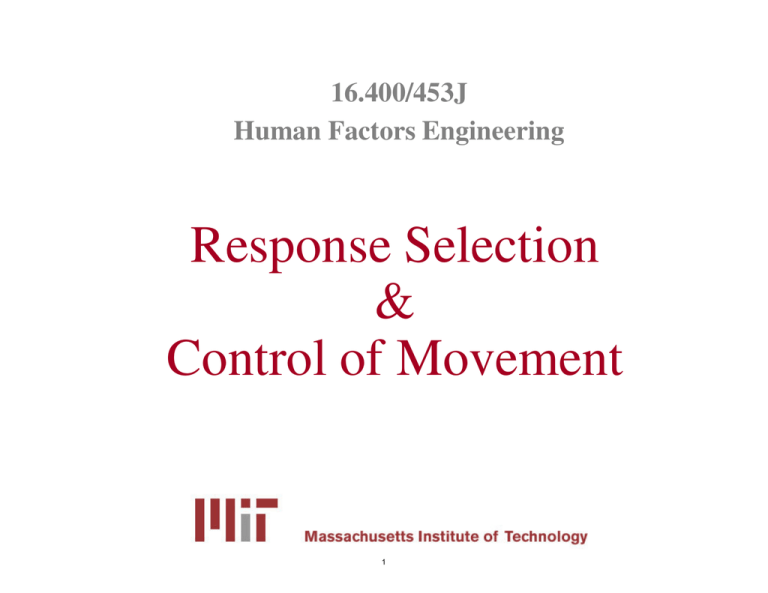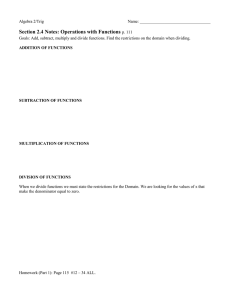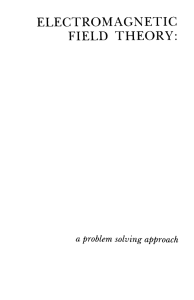Document 13356790
advertisement

16.400/453J Human Factors Engineering Response Selection & Control of Movement 1 Objectives 16.400/453 • Reaction times for increasing decision complexity – Simple, recognition, choice experiments – Hick-Hyman Law • Speed accuracy tradeoff – Fitts’ law • Stimulus-Response (S-R) compatibility • Feedback 2 Human Information Processing 16.400/453 Attention Resources Long-term Memory Sensory Processing Perceptual Processing Working Memory Response Selection Response Execution Feedback Image by MIT OpenCourseWare. 3 The selection of skill based responses 16.400/453 • Reaction Time Studies • Pioneer reaction time study was conducted by Donders (1868) – Simple reaction time is shorter than a Recognition (Go/No Go) reaction time – Choice reaction time is longest of all Donders, F. C. 1868. On the speed of mental processes. Translated by W. G. Koster, 1969. Acta Psychologica 30: 412­431. 4 Types of reaction time experiments 16.400/453 Simple reaction time experiments – only one stimulus and one response – 'X at a known location,' 'spot the dot,' and 'reaction to sound' Recognition reaction time experiments – there are some stimuli that should be responded to (the 'memory set'), and others that should get no response (the 'distractor set'). – Go/No Go: 'Symbol recognition' and 'tone recognition' Choice reaction time experiments – User must give a response that corresponds to the stimulus, (e.g., pressing a key corresponding to letter if the letter appears on screen) http://biae.clemson.edu/bpc/bp/Lab/110/reaction.htm#Kinds 5 Simple and choice reaction time 16.400/453 • In a simple reaction time (RT) situation – There is no uncertainty what the signal is – There is no uncertainty how to respond • Sprinter in the starting blocks • In a choice reaction time task (combines recognition and choice) – There can be more than one signal – More than one type of response – Each response corresponds to a signal 6 Factors affecting simple RT 16.400/453 Slide removed due to copyright restrictions. 7 Factors affecting simple RT 16.400/453 Slide removed due to copyright restrictions. 8 Factors affecting choice RT 16.400/453 • Factors affecting simple RT also affect choice • In a choice response time situation – user is transmitting information from stimulus to response • Hick (1952) and Hyman (1953) performed experiments – By varying number of stimulus-response alternatives • Hick-Hyman Law (H-H Law) – Choice RT increases linearly with stimulus information Hick (1952) On the rate of gain of information. Quarterly JEP, 4:11­26, 1952 Hyman, R. (1953). Stimulus information as a determinant of reaction time. JEP, 45, 423­432. 9 Hick-Hyman law 16.400/453 Reaction time When alternatives are equally likely RT=a+b*log2(N) Also holds when probabilities differ Decision complexity advantage (typing vs Morse code; deep vs. shallow menus) Number of alternatives (N) 10 Problems with Hick-Hyman 16.400/453 Slide removed due to copyright restrictions. 11 Speed accuracy tradeoff 16.400/453 • Possible to be fast and error prone OR slow and precise • People tend to make more errors when they respond more rapidly and vice versa • Due to strategies that reflect different payoffs between errors and response speed • Due to control devices that induce faster but less precise control 12 Control device effect 16.400/453 • QWERTY and Dvorak keyboards – Qwerty designed to avoid jamming in typewriters (1868) – Dvorak (1932) • QWERTY persists even though Dvorak is claimed to offer a 5-10% advantage This image is in the public domain. Further reading: http://wwwpub.utdallas.edu/~liebowit/keys1.html 13 Speed accuracy tradeoff 16.400/453 • Instructions, auditory vs. visual stimuli, stress • Regulations in the nuclear industry require workers to wait a certain amount of time before responding Accuracy Slow and accurate Neither slow nor accurate Fast and sloppy Reaction Time (sec) Instructions can change where a subject is on this curve. Image by MIT OpenCourseWare. 14 16.400/453 Speed accuracy tradeoff for aimed movements Fitts Law Movement time=a+b * log2(2A/W) = time required to rapidly move from a starting position to a final target area • • • • A=movement amplitude W=target width Very general law a and b depend on device and user characteristics W A 15 Fitts’ law 16.400/453 • Modified: Movement time=a+b * log2(A/W + 1) • Index of difficulty – log2(A/W + 1) or log2(2A/W) • Index of performance: – IP = 1/b 16 S-R compatibility 16.400/453 Slide removed due to copyright restrictions. 17 Location compatibility 16.400/453 Slide removed due to copyright restrictions. 18 Principle of congruence 16.400/453 Slide removed due to copyright restrictions. 19 Movement compatibility 16.400/453 Slide removed due to copyright restrictions. 20 Movement proximity 16.400/453 Slide removed due to copyright restrictions. 21 Movement proximity 16.400/453 Slide removed due to copyright restrictions. 22 Modality compatibility 16.400/453 Slide removed due to copyright restrictions. 23 Motor system 16.400/453 • Functions – movement – posture & balance – communication • Guided by sensory systems – internal representation of world & self – detect changes in environment 24 3 classes of movement 16.400/453 • Voluntary: reading, writing, playing piano – complex actions – purposeful, goal-oriented – learned: improve with practice • Reflexes: eye-blink, coughing, knee jerk – involuntary, rapid • Rhythmic motor patterns: chewing, walking, running – combines voluntary & reflexive acts – initiation & termination voluntary – once initiated, repetitive & reflexive 25 Movement and muscles 16.400/453 • Movement occurs at joints – Degrees of freedom (elbow vs. shoulder?) • Contraction & relaxation of opposing muscles – Agonists: prime movers - flexion – Antagonists: counterbalance agonists - extension • decelerate movement – Activity can be measured through EMG (electromyogram) Images of EMG removed due to copyright restrictions. 26 Sensorimotor integration 16.400/453 • Movement control more than contraction & relaxation – Accurately time control of many muscles – Make postural adjustment during movement – Adjust for mechanical properties of joints & muscles • inertia, changing positions • Sensory inputs guide movement – visual, auditory, tactile • location of objects in space – Proprioceptive & vestibular • position of our body • Critical for planning & refining movements • Closed loop vs. open loop control of movement 27 Error correction 16.400/453 • Feedback: – During or after movement – Compare actual position with intended position – Slower movements • Feedforward: – Sensory events control movements in advance • ballistic movements – Prediction: internal model of events – e.g. catching ball • representation of ball trajectory • properties of musculoskeletal system – Reevaluation after response completed 28 Feedback 16.400/453 • Feel of button (deflection of key and click of keyboard vs. membrane keyboard) • Feedback and delays: – less than 100 msec to avoid disrupting motor control – less than 1.0 sec to avoid disrupting thought – less than 10 seconds to keep user’s attention focused on the dialog. Feedback regarding magnitude of delay is critical. 29 General principles of control design 16.400/453 • Decision complexity – Simple choices have faster response than complex • Response expectancy – Reaction Time (RT) much smaller for expected events • Compatibility – Location and movement compatibility should match mental model • Speed-accuracy tradeoff – More errors with speeded response • Feedback – Display of system response 30 MIT OpenCourseWare http://ocw.mit.edu 16.400 / 16.453 Human Factors Engineering Fall 2011 For information about citing these materials or our Terms of Use, visit: http://ocw.mit.edu/terms.



